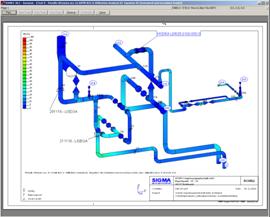ROHR2
Program System for Static and Dynamic Analysis
of Complex Pressure Vessels and Piping and also,
Skeletal Structures

In process plant construction, strictly legal conditions require a steady rising effort in documentation. At the same time a higher economic competition demands a continuous rationalization process to shorten the planning times. This requires a precise cooperation of all engineering divisions, a smooth communication is the necessary consequence.
Process piping systems are key systems of many industrial plants which require high quality designs as well as QA/QC.
Static Analysis: arbitrary loads and load combinations according to linear and nonlinear boundary conditions (friction, gap of supports, support up-lift, etc.)
- Dynamic Analysis: dynamic loads with harmonic excitation, and calculation of Eigen values and their analysis by means of different modal response methods ( e.g. fluid hammer forces). An efficient superposition modulus enables a versatile selection and combination of static and dynamic results as well as the generation of extreme values for loads on supports, components and nozzles.
Stress Analysis of pipe components can be done by variety of specifications such as ASME, KTA, EN 13480, DIN and AGFW.
Components design reviews: Expansion joint, spring design, internal pressure design, relief valves, etc.
Integrated planning systems with specialized components have a central meaning in the project planning. Such a “specialist” is ROHR2, the CAE – system for component analysis, construction, static and dynamic analysis of complex piping and skeletal structures.
Since more than 30 years ROHR2 supports engineers and designers worldwide with permanently developed program versions at the plant construction. Many well-known national and international plant construction companies as well as operators of the energy- , chemical - and petro-chemical industry trust in the quality of ROHR2.
The planned use of ROHR2 is component analysis, construction and structure analysis of complex piping systems.
The static analysis includes the analysis of arbitrary loads and load combinations according to first and second order theory for linear and nonlinear boundary conditions (friction, gap of supports, support uplift).
All loads can be put in as dynamic loads with harmonic excitation. Other parts of the dynamic analysis are the calculation of Eigen values and mode shapes and their analysis by means of different modal response methods (e.g. to analyze fluid hammer forces).. The earthquake analysis bases on the Time - History -Method. An efficient superposition modulus enables a versatile selection and combination of static and dynamic results as well as the generation of extreme values for loads on supports, components and nozzles.Stress analyses of pipe components can be done by a variety of specifications like ASME, KTA, EN 13480, STOOMWEZEN D1101 and AGFW.
For general beam elements (structural steel sections) equivalent stresses according to DIN 18800 are calculated.
Capabilities:- Design Verification
- Pipework Risk-based Vibration Assessment